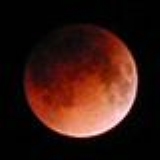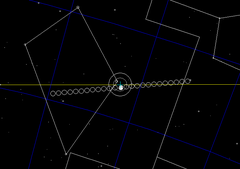
May 2004 lunar eclipse
Encyclopedia
| Total Lunar Eclipse May 4-5, 2004 http://eclipse.gsfc.nasa.gov/LEplot/LEplot2001/LE2004May04T.pdf |
|
|---|---|
 Haifa, Israel |
|
 The moon's path through the Earth's shadow. |
|
| Series (and member) Saros cycle The saros is a period of 223 synodic months , that can be used to predict eclipses of the Sun and Moon. One saros after an eclipse, the Sun, Earth, and Moon return to approximately the same relative geometry, and a nearly identical eclipse will occur, in what is referred to as an eclipse cycle... |
131 (33 of 72) |
| Duration (hr:mn:sc) | |
| Totality | 01:16:20 |
| Partial | 03:23:56 |
| Penumbral | 05:18:44 |
| Contacts | |
| P1 | 17:50:54 UTC |
| U1 | 18:48:20 UTC |
| U2 | 19:52:07 UTC |
| Greatest | 20:30:17 UTC |
| U3 | 21:08:27 UTC |
| U4 | 22:12:15 UTC |
| P4 | 23:09:37 UTC |
 The moon's path across shadow in Libra. |
|
A total lunar eclipse
Lunar eclipse
A lunar eclipse occurs when the Moon passes behind the Earth so that the Earth blocks the Sun's rays from striking the Moon. This can occur only when the Sun, Earth, and Moon are aligned exactly, or very closely so, with the Earth in the middle. Hence, a lunar eclipse can only occur the night of a...
took place on May 4, 2004, the first of two total lunar eclipses in 2004, the second being on October 28, 2004
October 2004 lunar eclipse
A total lunar eclipse took place on October 28, 2004, the second of two total lunar eclipses in 2004, the first being on May 4, 2004.- Visibility :...
.
Visibility

It was visible throughout most of Europe
Europe
Europe is, by convention, one of the world's seven continents. Comprising the westernmost peninsula of Eurasia, Europe is generally 'divided' from Asia to its east by the watershed divides of the Ural and Caucasus Mountains, the Ural River, the Caspian and Black Seas, and the waterways connecting...
and Asia
Asia
Asia is the world's largest and most populous continent, located primarily in the eastern and northern hemispheres. It covers 8.7% of the Earth's total surface area and with approximately 3.879 billion people, it hosts 60% of the world's current human population...
, eastern Africa
Africa
Africa is the world's second largest and second most populous continent, after Asia. At about 30.2 million km² including adjacent islands, it covers 6% of the Earth's total surface area and 20.4% of the total land area...
, Indian Ocean
Indian Ocean
The Indian Ocean is the third largest of the world's oceanic divisions, covering approximately 20% of the water on the Earth's surface. It is bounded on the north by the Indian Subcontinent and Arabian Peninsula ; on the west by eastern Africa; on the east by Indochina, the Sunda Islands, and...
and western South America
South America
South America is a continent situated in the Western Hemisphere, mostly in the Southern Hemisphere, with a relatively small portion in the Northern Hemisphere. The continent is also considered a subcontinent of the Americas. It is bordered on the west by the Pacific Ocean and on the north and east...
including the Pacific Ocean
Pacific Ocean
The Pacific Ocean is the largest of the Earth's oceanic divisions. It extends from the Arctic in the north to the Southern Ocean in the south, bounded by Asia and Australia in the west, and the Americas in the east.At 165.2 million square kilometres in area, this largest division of the World...
. The eclipse seen in eastern Asia
Asia
Asia is the world's largest and most populous continent, located primarily in the eastern and northern hemispheres. It covers 8.7% of the Earth's total surface area and with approximately 3.879 billion people, it hosts 60% of the world's current human population...
before sunrise and western South America
South America
South America is a continent situated in the Western Hemisphere, mostly in the Southern Hemisphere, with a relatively small portion in the Northern Hemisphere. The continent is also considered a subcontinent of the Americas. It is bordered on the west by the Pacific Ocean and on the north and east...
after sunset. The eclipse was seen over the Philippines at dawn.
Lunar year series
It is the third of four lunar year cycles, repeating every 354 days.See also
- List of lunar eclipses and List of 21st century lunar eclipses
- May 2003 lunar eclipseMay 2003 lunar eclipseA total lunar eclipse took place on May 16, 2003, the first of two total lunar eclipses in 2003, the other being on November 9, 2003.- Saros series :It is a member of Saros cycle 121.- Lunar year series :...
- November 2003 lunar eclipseNovember 2003 lunar eclipseA total lunar eclipse took place on November 9, 2003, the second of two total lunar eclipses in 2003, the first being on May 16, 2003.-Photo gallery:-Lunar year series:It is the second of four lunar year cycles, repeating every 354 days....
- October 2004 lunar eclipseOctober 2004 lunar eclipseA total lunar eclipse took place on October 28, 2004, the second of two total lunar eclipses in 2004, the first being on May 4, 2004.- Visibility :...
External links
- NASA
- http://apod.nasa.gov/apod/ap040506.html APOD 2004 May 6, A Lunar Eclipse Mosaic, from Greece
- http://apod.nasa.gov/apod/ap040508.html APOD 2004 May 8, Good Morning Sydney, Sydney Australia
- Photos
- Spaceweather.com: Lunar eclipse gallery

